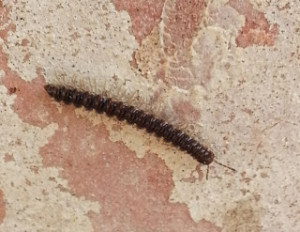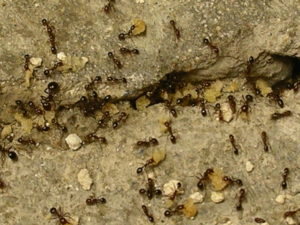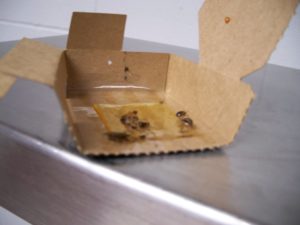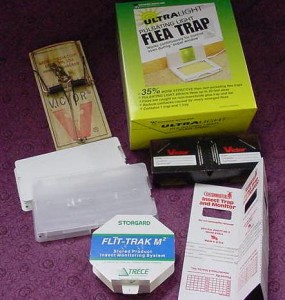Hot Weather and Pests By Dr. Mike Merchant
It’s summer in Texas and either you saw too much rain this spring, or not enough but no matter where you live the summer pests are out.
Some pests are more troublesome during extreme conditions, while others flourish during more typical conditions. Here are a few observations concerning current weather conditions and pests.
- Millipede mass migrations commonly occur in the fall, but can also happen in the spring and summer. Above average
 rainfall is likely to blame for this year’s invasions. But such invasions don’t occur overnight, as it takes millipedes several months to develop. It may be that waterlogged soils are forcing millipedes out of the soil in search of drier spots. For this reason it’s usually unnecessary to spray insecticides indoors for millipedes. Instead use the vacuum indoors and focus your control actions outdoors. Make sure mulch is kept away from building foundations, and that weep holes and other entry points are screened or sealed. In severe cases it may be helpful to apply a pyrethroid insecticide (in the form of granules or sprays) around the perimeter of the building and around windows and doorways. Most of the time, however, millipede infestations go as quickly as they came, and insecticides are not needed.
rainfall is likely to blame for this year’s invasions. But such invasions don’t occur overnight, as it takes millipedes several months to develop. It may be that waterlogged soils are forcing millipedes out of the soil in search of drier spots. For this reason it’s usually unnecessary to spray insecticides indoors for millipedes. Instead use the vacuum indoors and focus your control actions outdoors. Make sure mulch is kept away from building foundations, and that weep holes and other entry points are screened or sealed. In severe cases it may be helpful to apply a pyrethroid insecticide (in the form of granules or sprays) around the perimeter of the building and around windows and doorways. Most of the time, however, millipede infestations go as quickly as they came, and insecticides are not needed. - Drought and high temperatures put many trees and shrubs under stress. Stressed plants are more susceptible to some pests, especially borers. Extra care should be directed towards valuable landscape plants during periods of drought. Make sure high value trees receive extra water, look for signs of borers or other stress. At the first sign of borer attack, consider applying a borer preventive spray, such as permethrin.
- Spider mites are another landscape pest likely to cause more damage during hot weather. Inspect shrubs and plants for the telltale yellow stippling patterns on the tops of leaves. Water mite prone plants regularly, prune the most heavily infested plant parts when practical and consider applying a mite control product to high value plants.

Fire ants carrying bait back into the nest to feed the queen and brood.
- Fire ants may appear to disappear during stretches of hot, dry weather. Don’t be fooled; fire ants still flourish underground. They will reappear quickly following rain events. If you have not already treated sensitive areas for fire ants, do it now. Most fire ant baits and residual insecticides require several weeks for control. Apply fire ant baits as late in the day as possible—early evening is best. Fire ants do little foraging during the day in mid-summer, and baits exposed to the baking sun degrade quickly if applied during the heat of the day. Fire Ants and the Texas IPM in Schools Program
- Rodents are often driven to buildings to seek water and escape extreme temperatures. Summer is an ideal time to ensure that buildings are pest proofed and rodents are under control. Remember they only need the size of 1/4 inch the size of a dime to start to make entry into your building. This is also a good time to start watching the bats as well, if they have made a home in your building within the next few weeks you can start watching when they leave so you can start to prepare to seal up and exclude them from your campus this fall.
- As temperatures rise and creeks and ponds dry up, conditions improve for certain species of mosquitoes. Eliminate or treat small bodies of standing water in creek beds, ditches or temporary ponds. Such sites are more likely to breed encephalitis and West Nile virus-bearing mosquitoes. Visit our website Mosquito Safari for a great watch to and learn about mosquitoes. Great resource for teachers as well!
Monitoring for Insects. When is it necessary?
Nearly every book, leaflet and training course on integrated pest management touts the importance of using traps and sticky cards and monitoring for pests. If you are not monitoring, the sources say, you are not really doing IPM. At the same time, the Texas School IPM Rules also require that you monitor, but how do you do it?
 As many IPM coordinators soon learn, monitoring and record-keeping is time-consuming and expensive. And just what do you do with all those numbers and data? Technicians typically have a limited amount of time they can spend in an account or a given school, and time spent checking traps and recording numbers of insects can take away from other more important activities. And yet this is one of the most important steps in pest management – if you don’t know what you have and how much you have then how do you effectively treat?
As many IPM coordinators soon learn, monitoring and record-keeping is time-consuming and expensive. And just what do you do with all those numbers and data? Technicians typically have a limited amount of time they can spend in an account or a given school, and time spent checking traps and recording numbers of insects can take away from other more important activities. And yet this is one of the most important steps in pest management – if you don’t know what you have and how much you have then how do you effectively treat?
Monitoring is defined as use of a sampling method to record pest presence or pest abundance over time. Monitoring, then, can have two functions: detecting pest presence and keeping track of pest abundance over time.
If a pest management technician places sticky cards in a kitchen for cockroaches, but does not check them during each service visit, he/she is not really monitoring. Similarly, if they do not record their findings in a service log, spreadsheet or record-book, then they are not really monitoring.
Monitoring is best done with a specific goal in mind. For example, suppose your district has a kitchen with cockroaches—one of the best-suited pests for monitoring. As the pest management decision maker you want to know if your treatment program is eliminating cockroaches. That is your goal. The technician should record fresh cockroach numbers in a notebook each service visit and those numbers should be averaged and (preferably) charted out to see whether control measures are working.
This sort of monitoring can be a powerful tool. Similarly, traps might be used in a roach-free kitchen to detect problems before they get out of hand. When monitoring for detection fewer traps are usually needed. Detection traps should be placed in areas of previous trouble or where roaches are most likely to enter the building (such as receiving docks and storage rooms).
Do school districts need to maintain sticky traps in all areas of school buildings? Probably not. A monitoring program without a

Depending on your pest, choose the right monitoring device, each one of these devices work for different pests.
cause eventually runs out of steam, stranding lonely and neglected monitoring stations throughout the school. The thousands of dusty and forgotten sticky cards and glue boards found in schools throughout the state serve as a testament to monitoring programs with no goal in mind.
The average school district probably has only one or a handful of locations where intensive population monitoring is necessary. Otherwise, monitoring station use should be kept to a minimum to give pest control technicians more time to focus their inspections on more productive activities. However, this is a good time of year to meet with your pest management professionals and determine what areas need additional monitoring and which areas should be revisited during fall break.
The district written IPM program is designed to help the coordinator, pest management staff and school administrators understand their roles in monitoring for pests and preparing for them before they appear.
Monitoring method |
Pests Targeted |
Comments |
| Sticky cards | Cockroaches, spiders, scorpions, general small crawling insects | Keep out of sight and in contact with wall edges. Note where placed so they can be retrieved |
| Pheromone traps | Clothes moths, stored product moths, carpet beetles | Very powerful sex attractants make excellent detectors even of small populations |
| Food traps | Rodent (non-toxic) monitoring stations, stored product beetles, fruit fly traps, yellow-jacket wasp traps, termite monitoring stations. | Stations or traps that hold a small amount of attractive food. Some stations can be switched to hold toxic bait once feeding or visiting is detected. |
| Light traps | House flies, night-flying insects | Should be placed out of view from doorways to avoid attracting pests from outdoors. |
| Glue boards | Snakes, crawling insects, spiders | A heavier duty version of the sticky card. You must develop a procedure for what to do with captured animals. Messy. |

 .
.